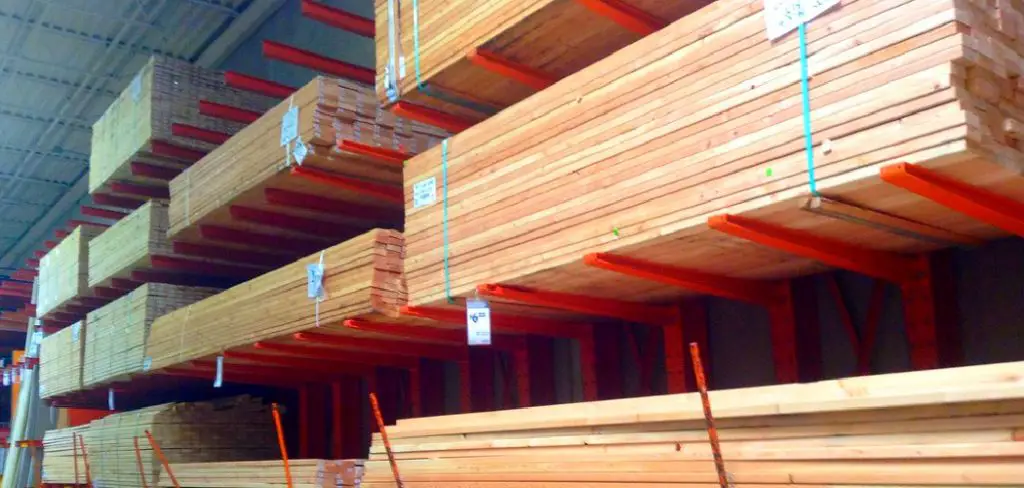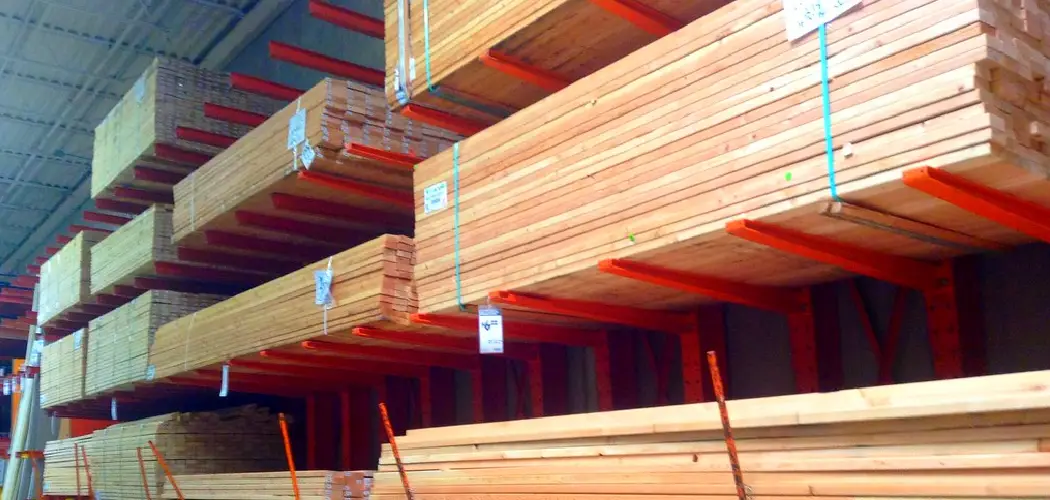When it comes to storing lumber, there’s more to it than just stacking a few boards in the corner. Whether you purchase pre-cut pieces of wood or have timber cut specifically for your project, knowing how to safely and properly store lumber can make all the difference when it comes time to use the material.

With that being said if you’re looking for tips on how to store lumber effectively and ensure its long-term safety and stability—you’ve come to the right place! In this post, we’ll be exploring best practices for storing different types of lumber so that you can increase your project’s chances of success with ease.
Is It Ok to Store Lumber Vertically?
Storing lumber vertically can be done, but there are a few considerations to keep in mind. Due to the weight of most lumber, you should make sure that the vertical supports for your lumber storage rack are strong and securely fastened into place. Additionally, you should avoid storing wet wood vertically because it may warp or bend as it dries.
Pressure-treated wood should also not be stored vertically due to issues with moisture absorption and potential warping. If possible, try to store your lumber horizontally in an area where air can circulate around each piece of wood. This will help reduce any issues with warping or splitting due to uneven drying or improper storage conditions.
Finally, use spacers between each layer of boards when stacking them, as this will ensure that air can circulate and help promote even drying. This is especially important if you are storing lumber outdoors. Taking the time to properly store your lumber, whether vertically or horizontally, will give you peace of mind and ensure that your wood remains in good condition for years to come.
10 Methods on How to Store Lumber
1. In a Dry Area
One of the best ways to store lumber is in a dry area. Lumber should be stored in an area that is not prone to moisture or humidity. If possible, store lumber in a shed or garage. If this is not possible, try to find a spot in your home that is away from windows and doors to reduce the amount of moisture that can enter the area.
If stored outside, make sure the area is well-ventilated and that you use proper waterproofing to keep moisture out. While storing lumber outside is an option, it is not recommended as exposure to the elements can cause warping or cracking. To further reduce the possibility of moisture, you can use a dehumidifier in the area where you store your lumber.

2. On a Level Surface
Another important way to store lumber is on a level surface. Lumber should not be stored on the ground, as this can cause the boards to warp or crack. Instead, store lumber on a flat surface such as a table, shelf, or pallet.
This will help to keep the lumber in good condition and prevent any damage. If possible, use a tarp or plastic sheeting to protect the lumber from moisture and insects. Additionally, you should make sure to leave plenty of room between the boards to allow for air circulation. This will help to reduce the risk of mold and mildew forming on the wood.
Finally, it’s important to rotate the boards periodically so that each side of the lumber gets a chance to dry out. This will help to keep the wood from warping or bending. With the right care and storage, your lumber will remain in excellent condition for many years.
3. Stack the Lumber Properly
When stacking lumber, it is important to do so properly. Begin by stacking the heaviest boards on the bottom and then work your way up to the lighter boards. Make sure that each row is level and that the boards are evenly spaced. This will help to prevent the lumber from shifting or falling over. It is also important to avoid stacking the boards too high.
If you are stacking a large number of boards, it may be necessary to use supports in between each layer. This will help provide additional stability and reduce the chances of the stack collapsing. Additionally, if possible, store the lumber off the ground on pallets or a rack system. Doing so will help protect the lumber from moisture and dirt, both of which can cause damage to the wood.
4. Cover the Lumber
If you will be storing lumber for an extended period of time, it is important to cover it. This will help to protect the lumber from dust, dirt, and moisture. You can cover lumber with a tarp, plastic sheeting, or even old blankets or towels. Just make sure that whatever you use is clean and dry before covering the lumber.

Also, be sure to check the covering periodically for any signs of excessive moisture or damage. If you find any, replace the covering immediately. Storing lumber properly is essential for maintaining its quality and preserving its integrity. With a little bit of care and attention, you can make sure your lumber is in great condition for use whenever you need it.
5. Do Not Store Lumber Near Chemicals
When storing lumber, it is important to keep it away from chemicals such as cleaners, paints, and solvents. These chemicals can damage the wood and cause it to warp or discolor over time. If you must store lumber near chemicals, make sure that they are stored in a well-ventilated area to minimize exposure.
Additionally, use a plastic tarp to cover the wood and protect it from chemical spills. Finally, inspect the lumber periodically to make sure that no damage has occurred due to exposure. With these precautions in mind, you can ensure that your lumber is safely stored away from dangerous chemicals. If you are storing lumber in or near an area where chemicals are present, it is best to take extra precautions to protect the wood.
6. Inspect the Lumber Regularly
It is important to inspect stored lumber regularly for signs of damage, such as warping, cracking, or splitting. If you notice any damage, remove the affected boards from storage and either repair them or discard them, depending on the severity of the damage.
Regular inspection will help to keep your stored lumber in good condition for years to come. Additionally, if you plan to use the wood for a project in the near future, inspecting it regularly will ensure that you are using the best quality lumber for the job.
7. Label the Lumber
It is also helpful to label each piece of stored lumber. This will allow you to easily identify which boards are which and make it simpler to find the exact piece of lumber you need for your project. You can use color-coded labels or a Sharpie marker to label each board with its measurements or type of wood.
This will help keep everything organized and prevent any confusion when you go back to retrieve a certain piece of lumber. If you plan on storing lumber for a long period of time, make sure to check the labels periodically to make sure they don’t fade or wear off.

8. Remove any Dirt or Debris
Before storing lumber, make sure to remove any dirt or debris from the boards. Dirt and debris can cause damage to the boards and lead to rot, mold, and other issues. This can be done by sweeping or vacuuming the surface of the lumber. Additionally, any nails or screws should be removed before storing lumber to avoid puncturing other pieces of wood.
9. Clean the Lumber
Clean the lumber before storing it to prevent any dirt or debris from sticking to the wood. This will also help to keep moisture out and prevent mold or mildew from forming. Use a soft cloth or brush to gently remove any dust and dirt from the surface. Do not use any abrasive materials, as this can damage the wood. Once the lumber has been cleaned, it is ready to be stored.
10. Keeping the Lumber Protected
Using a wood sealer or protectant can help to keep your stored lumber in good condition. A sealer will help to keep the wood from drying out and cracking, as well as from absorbing moisture. Some sealers are designed specifically for outdoor lumber and can make it easier to clean up if the lumber is exposed to rain or snow. In addition, a good sealer will also protect against UV rays that can cause fading and discoloration of the wood.

Conclusion
All in all, storing lumber is not as intimidating as it may seem. With the right techniques and patience, your wood will stay in usable condition for years to come. By following these steps and determining which technique works best for your specific situation, you can ensure that your lumber supply is ready to use when you need it.
With the help of proper storage, no project should be delayed due to improper storage. So, if you’re looking for more information on how to store lumber properly, then take the time to do some research today! You’ll be glad that you did!

